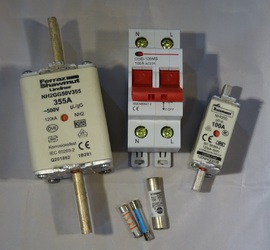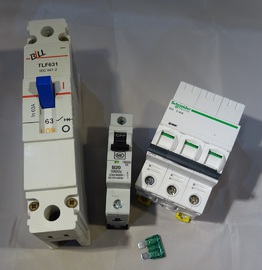Fuse Sizing
Fuses are a device for interrupting the current in a circuit to prevent damage to property and equipment. Some fuses consist of a wire link within a container and this link is destroyed by high fault currents. Such fuses operate only once before they need replacing. Other fuses are of the familiar circuit breaker type and can be reset once they have tripped. It is important to remedy the problem that made the circuit breaker trip in the first place though!
Before going any further there's a bit of myth busting to do here. A fuse is to protect electrical cable supplying power to current using equipment. Most people believe the fuse is to protect the equipment itself but the following example will show what I mean.
A kettle rated at 2kW has a 13 Amp fuse in the plug and the mains voltage is 230V
13 Amps x 230V = 2.990 kW (for the purposes of this of this example we've simplified power)
Even allowing for inconsistencies in the kettles performance this would seem like and oversized fuse.
If the flexible cable has a cross sectional area of 1.5mm (usually written on the side) then by using the manufacturers data we can see the this cable has a maximum current rating of 16A. Allowing a 10% safety for the 13A fuse means that even at 14.3 Amps the fuse will blow before the cable is damaged.
The key figures to use when sizing a fuse are the current required by the device when operating normally, and the rated current of the cable. You should never size the cable exactly to the current requirements – in the example of the kettle you could use cable with a cross sectional area of 1.25mm as according to the manufacturers tables this cable will take a maximum of 13A. In doing so there is no margin for error and the cable is likely to run 'hot'. Taking 'volt drop' into account when calculating cable sizes will generally produce quite a large safety margin anyway as well as contributing to the overall efficiency of the design.
So how do we apply the theory to the practice in a renewable energy installation?
If we look at an off grid Solar PV installation with a battery store we may need fuses in several locations. Starting at the top as it were, depending on how the PV modules are wired you may need fuses to protect the cable on each 'string' (a string is a number of PV modules connected together). If the DC cable has been sized correctly then the fuse rating is the maximum current x 10%. A typical solar PV 'string' will produce a maximum current of around 8.5 Amps. Adding 25% (This 25% figure is in the PV design guidance documents) gives 10.625 Amps. Now if you go to your renewable energy supplier (hopefully that will be us) and look for a 10.625A fuse you might be disappointed!
You can only use the fuse sizes that are available, so select the nearest size but remember it must be slightly above the normal current rating but below the maximum rated current figure for the cable. In most cases a 10A or 15A fuse per string is fine if you have multiple strings being combined to give a higher current for battery charging purposes.
Next in the sequence is the charge controller, whose function is to safely charge the batteries with all that useful solar energy for a time when you need to use it. Some charge controllers will incorporate a fuse, but you would calculate the fuse in the same way as you would the 'string'. You need the normal operating current of the device and the maximum rating of the cable. In some cases you may want to protect the batteries from damage due to over current caused by a fault. Again to do this you need to know the maximum charge rate for the batteries - known as the 'C' rating and size the fuse accordingly taking into account the rating of the cable.
On the output side of the system you may want a fuse in addition to those often incorporated in the inverter. You will know your maximum current rating for the inverter or the maximum discharge rate for the batteries and size with the addition of 10%.
The fuses we have discussed so far are DC devices and it is very important to use DC rated fuses for DC and AC rated fuses for AC.
On the AC side of the inverter you will need a conventional AC fuse, you can work this out by using the capacity of the inverter in kW and dividing by the voltage...
For example 4kW (4000W)
4000 / 230 = 17.39 Amps
The nearest size would be a B20 type fuse for AC. Fuses for AC and DC look quite different, DC string fuses often look like 'Cartridge fuses' and are cylindrical in shape, and this is certainly the case for string fuses. AC fuses often look like the circuit breakers found in 'fuse boxes' in a domestic property.
Two other things to remember, fuses aren't switches and you must have isolation switches in your circuit too. These will be used for maintenance and safety isolation. Point two – if in doubt ask a qualified electrician, there is some work which you are not permitted to do without qualifications and permission form local building control.















